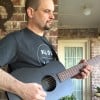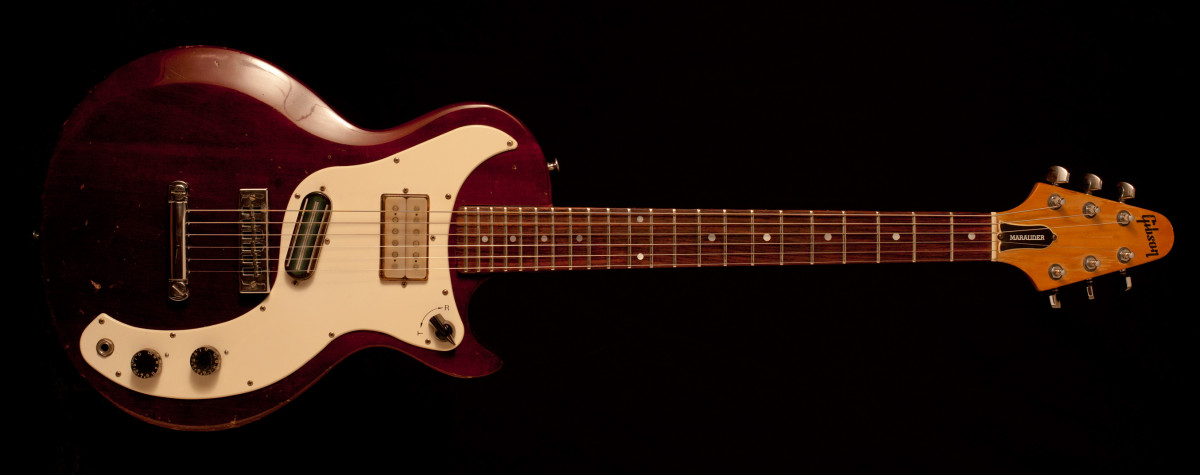Fiche technique
- Fabricant : Gibson
- Modèle : S-1
- Catégorie : Guitares de forme LP
- Autres dénominations : s 1, s1
Source: Reverb.com + personal add
https://reverb.com/fr/price-guide/guide/1167-gibson-s-1-1976-natural
The S-1 and its counterpart, the Marauder were introduced by Gibson introduced in the '70s to try to get in on the lower-end guitar market dominated by Fender and Japanese makers. Unlike most Gibsons, these models used bolt-on necks. The S-1 differed from the Marauder in its three single-coil pickups with four-way rotary switch, as well as its standard Maple fretboard.
Years of Production: 1975 - 1982
Body Style: Single cutaway solidbody
Wood Composition: Alder, Mahogany, or maple body, Maple neck, Maple fingerboard
Design Elements: Three single-coil pickups Bill Lawrence, dot inlays, two control knobs, three-way pickup selector, Black pickguard, stopbar tailpiece and Tune-o-matic bridge, triangular headstock
Finish Specifications: Natural was the original finish for the Marauder.
Notable Les Paul Players: Ron Wood, Thurston Moore
Source:https://spinditty.com/instruments-gear/The-Gibson-Marauder-Guitars
"Clearly the S-1 is a brother, or at least a cousin to the Marauder. What happened was the Marauder's sales were quite good in its first year of production, and so the next year Gibson released the S-1 with confidence. There can be no doubt the S-1 was meant to take on the Fender Stratocaster. The pickups and circuitry here were again designed by the great Bill Lawrence.
The most of the S-1 guitars were of alder body. Mahogany and maple were both options for bodies though, and there was also an option for a maple fingerboard instead of the standard rosewood. Before the instrument was discontinued, the maple fretboard had become the standard, and rosewood the option.
Bill Lawrence designed the circuitry of the Gibson S-1, and this was cutting edge stuff for the mid 1970s. As a matter of fact, the circuitry would be considered every bit as advanced and cool were it in production today. The circuits involved a simple two way switch, and then the infamous chicken head switch. In this case, the chicken head was a 4 way rotary toggle.
The 4 way switch allowed for the use of neck + middle pickups, middle pick-up + bridge pick-up, all three together, and lastly, the neck and bridge out of phase. When the simple two way toggle switch was engaged, the rotary switch was bypassed completely; and this allowed for the guitar to emulate the Fender Strat and Tele.
Gibson and Fender are the big two American guitar manufacturers, and we almost always agree they are both wonderful. What makes it so wonderful, to me, is the way Gibson electric guitars are so very different from Fender electric guitars. Both great companies have, however, ventured into crossover style instruments where they copy some of the ideas and vibes of the other.
Everyone knows Gibson excels at producing set neck solid body guitars with humbucking pickups, and Fender excels at making bolt on neck solid body guitars with single coil pickups. But neither manufacturer has any sort of exclusive rights to those design elements, and so it happens we sometimes get guitars like the Gibson Marauder.
People who are into guitars have fantasies about the things. Fantasies like finding a classic guitar at a garage sale, flea market, or pawn shop where the seller thinks very little of the guitar, and you get it for a price you will tell people about for years and years. Well, the Gibson Marauder isn't going for cheap where people know about them, but it is possible someone at a fast moving garage sale thinks the Marauder some cheap toy.
The Marauder doesn't really look like a Gibson, and it certainly doesn't look like any of the ones everyone knows about the most. The headstock is all wrong, and the neck is bolted to the body. Someone could think the guitar is something else, and someone forged the Gibson name on it. I'm not advocating anyone rip someone off, or deceive their way into a score, but if someone has a low opinion of a thing and has it for sale, well, you don't hurt them by taking it off their hands.
The Gibson Marauder is kinda rare. We know for an absolute fact only 7,200 of them were ever created. Surely not all of those guitars exist now. Fires, floods, car wrecks and other things happen, and certainly some have passed on into trash. The first Marauder guitars were made in 1974, the last in 1982.
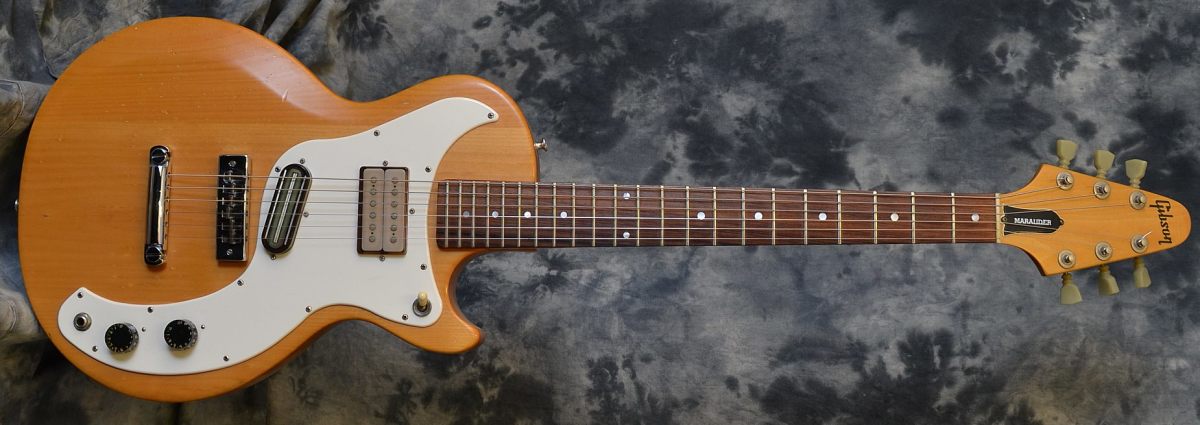
Bill Lawrence went to work for Gibson in 1972, but 'Hot Bill' had been a name known to guitarists for long years. Born in Cologne, Germany as Willi Lorenz Stich, Bill was a early proponent of the electric guitar as a player, and designer of electric guitar pickups. Bill Lawrence pickups are hot commodities today, and likely will be for many years to come.
The Gibson Marauder was not the first guitar which Lawrence helped design for Gibson; but the Marauder's pickups were pure Bill. The Marauder's Lawrence pickups come much closer to approximating the sound of a Fender guitar than any others Gibson had ever had produced, and the layout and design of the Marauder seem to make the guitar something clearly meant to compete against the Fender Telecaster Deluxe.
Both pickups on the Gibson Marauder were humbuckers. Yes, the slanted blade style pickup at the bridge appears to be a single coil. The bridge pickup is not a single coil pickup, it is a small humbucker. You will see conflicting statements on this, but Gibson's own website states they are both humbuckers.
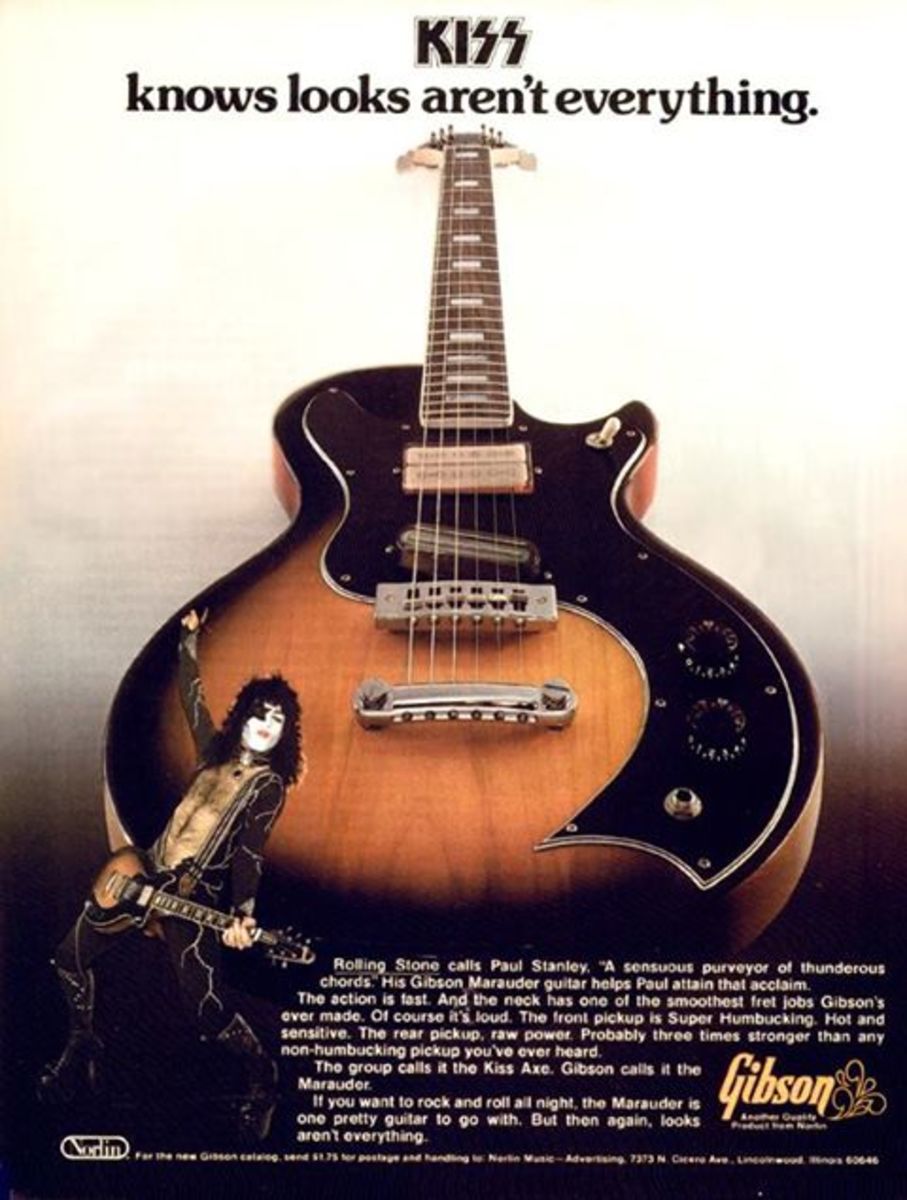
KISS was a pretty big deal when the Gibson Marauder hit the market. No, KISS wasn't a big deal musically, they were more entertainers than musicians. KISS, of course, was a costume act where there was some cheesy pop rock music included for whatever you paid. The guys in KISS stand out as persons who'd sell you anything at all. But don't let Paul Stanley and Ace Frehley endorsing the Marauder cause you to think ill of the thing.
The Marauder is a great guitar, regardless of what painted weirdo endorses it. The 1970s were a decade where suddenly American made guitars were facing some serious competition for the first time. The Japanese were moving into the guitar market in a big way, and they've never left. Also, in amplified and distorted music genres, the times were changing from heavy blues album rock to thrash punk. The Marauder would make for a fine punk rock guitar today too.
The woods used for the bodies of these instruments were not consistent at all. Gibson typically uses mahogany bodies for solid body electric guitars, and they used mahogany bodies for some of the Marauder guitars. The thing is, they also used maple bodies, and alder bodies. Alder is a wood Fender is most associated with. So it isn't really surprising that Gibson would use alder for a guitar which utilized a Fender like bolt on neck construction. What is surprising is they'd use a solid maple body at times. Maple is very heavy, and so the maple bodied Marauders may be something too heavy to stand and play for long periods for some persons.
Yet another Fender idea presented itself on the fretboard. The Marauder was offered with a traditional rosewood fretboard, or a maple fretboard. Gibson has warmed to the idea of using maple for fretboards over the years, but it's still not anything close to common for them. The fingerboard positioning markers were also varied for the Marauder. Some had dots, some had trapezoids.
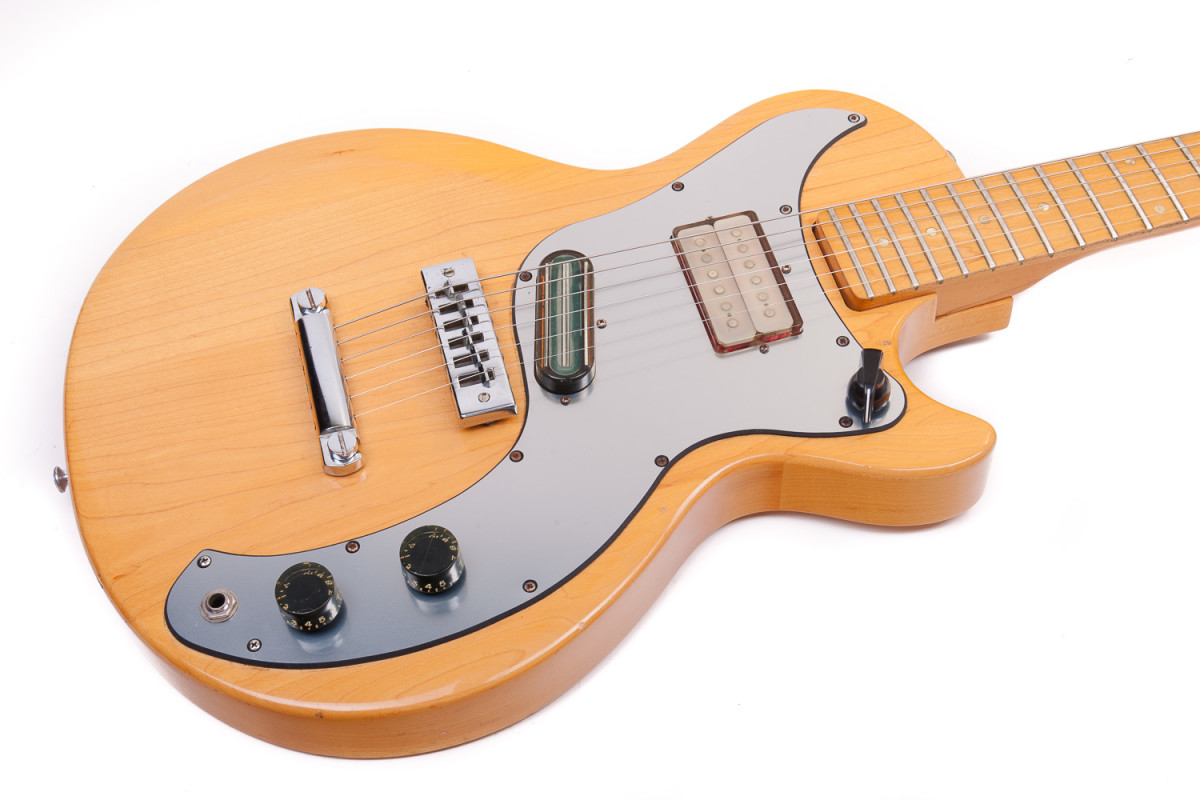
The Gibson Marauder's hardware was unlike that of the company's more well known guitars. But just how odd the hardware was on an individual instrument depended upon what year it was produced. The pickup selector switch was initially the typical toggle, same as found on the Les Paul, the SG, and any number of others. It was just located on the opposite side of the upper bout.
Then the toggle was replaced with a rotary 'chicken head' switch. Yes, that is what we often call those style of switches. If you look at the things closely, you can see the chicken head shape. The chicken head rotary switch didn't simply replace the toggle switch. The device underneath changed entirely to that of a potentiometer, allowing for a blending of tones via the switch. The rotary switch and potentiometer first appeared in the Marauder in 1976.
You can also see the Schaller bridge used is anything but a typical tune-o-matic. The stop bar tailpiece is the typical kind, but the bridge is a 'harmonica' by Schaller. Why Gibson chose to utilize these isn't exactly clear. There had to be a logical engineering reason for this, however. Perhaps Bill Lawrence preferred the Schaller bridge.
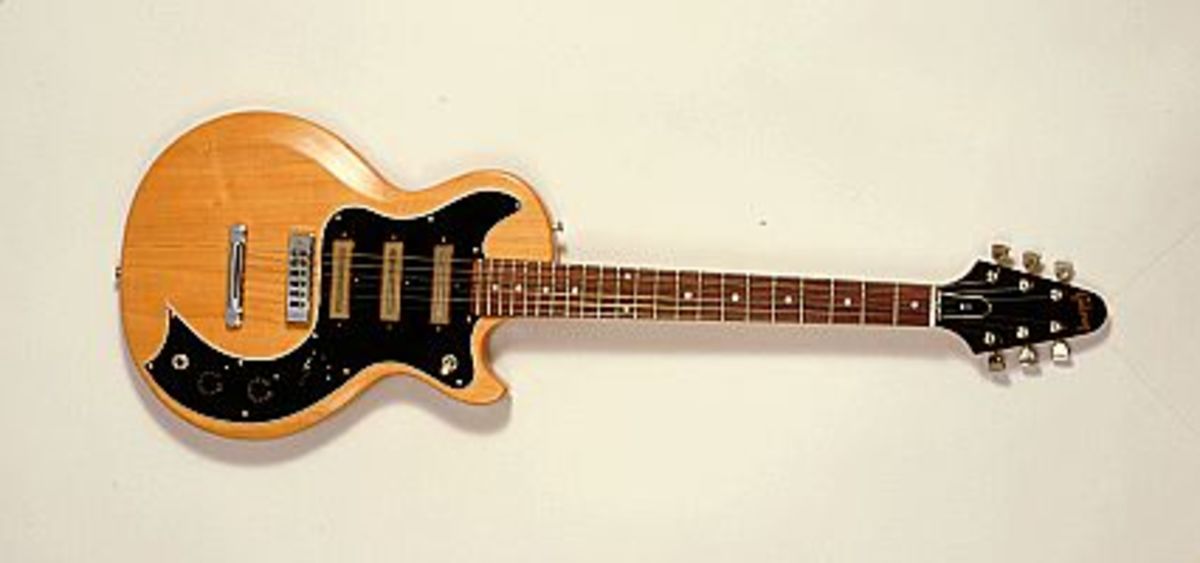
Clearly the S-1 is a brother, or at least a cousin to the Marauder. What happened was the Marauder's sales were quite good in its first year of production, and so the next year Gibson released the S-1 with confidence. There can be no doubt the S-1 was meant to take on the Fender Stratocaster. The pickups and circuitry here were again designed by the great Bill Lawrence.
The most of the S-1 guitars were of alder body. Mahogany and maple were both options for bodies though, and there was also an option for a maple fingerboard instead of the standard rosewood. Before the instrument was discontinued, the maple fretboard had become the standard, and rosewood the option.
Bill Lawrence designed the circuitry of the Gibson S-1, and this was cutting edge stuff for the mid 1970s. As a matter of fact, the circuitry would be considered every bit as advanced and cool were it in production today. The circuits involved a simple two way switch, and then the infamous chicken head switch. In this case, the chicken head was a 4 way rotary toggle.
The 4 way switch allowed for the use of neck + middle pickups, middle pick-up + bridge pick-up, all three together, and lastly, the neck and bridge out of phase. When the simple two way toggle switch was engaged, the rotary switch was bypassed completely; and this allowed for the guitar to emulate the Fender Strat and Tele.
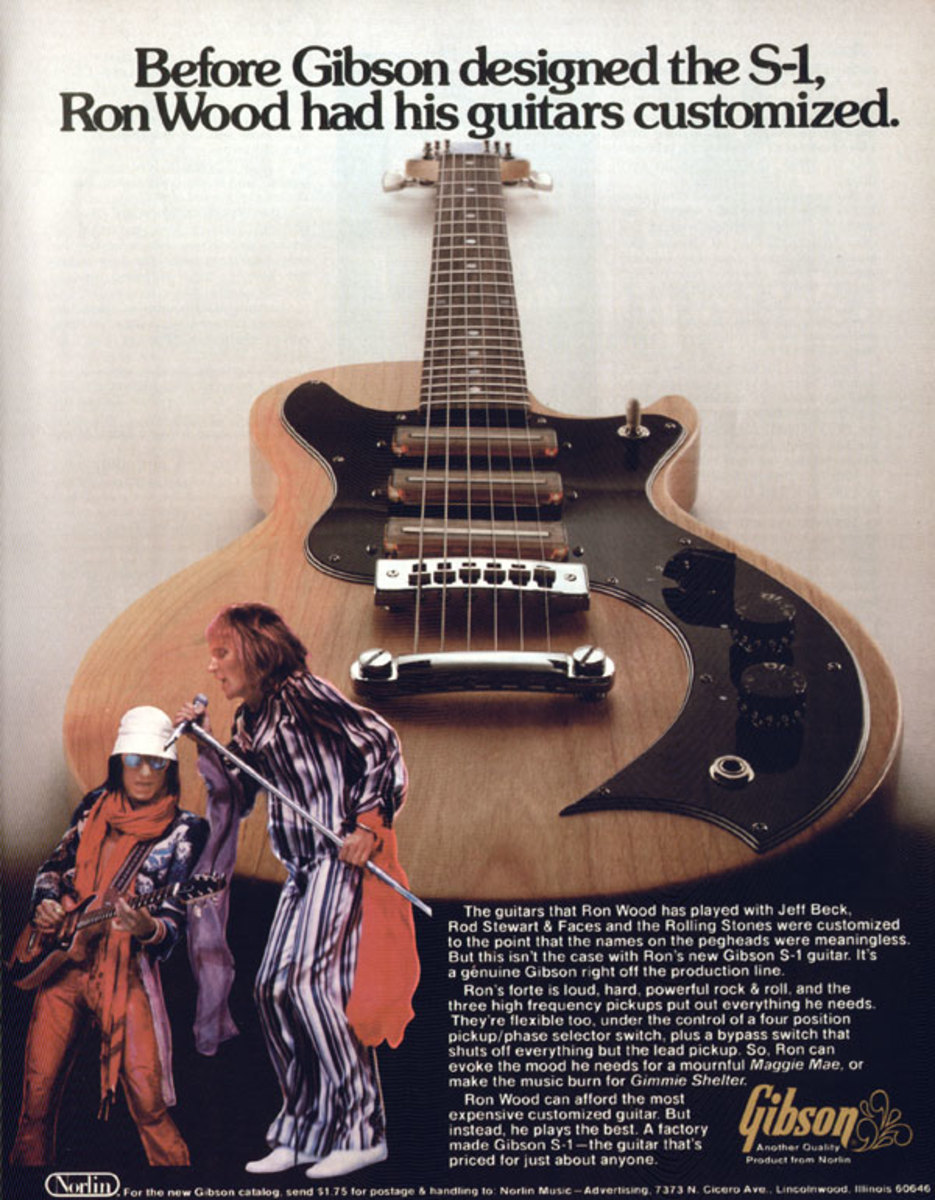
Ron Wood, famously a Telecaster guy, endorsed the Gibson S-1. But when you're a famous guitarist, you typically have exactly as many nice guitars as you want to have. Ron Wood wasn't hardly the only guy to dig into the Gibson S-1 though, he wasn't even the only guitarist in The Rolling Stones to play one. Of course Keith Richards spent some time playing the S-1 too. Carlos Santana spent enough time playing one to be closely associated with the instrument.
So you'd think the S-1 would still be produced today, but this is not the case at all. Both the Marauder and the S-1 were phased out of production in 1980. What they were replaced with was another thing altogether, and also equally different. Gibson used the design, but replaced the body wood with sawdust, woodchips, and glue. You read that correctly. They called it 'resonwood.' The Gibson Sonex was launched as the Marauder and S-1 were discontinued.
So what do these no longer in production and somewhat rare guitars fetch on the market? There are some bargains out there. But the reality is the asking prices for these guitars are pretty dang high. Places like Reverb dot com are where you'll see the most of them, but those people all know they are rare, and examples in good condition are selling for over a thousand dollars. This is why I think the best place to find one is when you're not expecting it, at a flea market, or in someone's garage sale
"
Vidéos
Avis utilisateurs
Sonne comme une Les Paul
Publié le 16/12/22 à 00:31Peut-être un poil lourde...
Du son Gibson sans concession, du lourd... Des basses qui tiennent...
Switch en position 2 généralement...
Les micros aux bobinages apparents d'origine
Elle tient très bien l'accordage même après avoir été "délaissée" un moment...
…
Peut-être un poil lourde...
Du son Gibson sans concession, du lourd... Des basses qui tiennent...
Switch en position 2 généralement...
Les micros aux bobinages apparents d'origine
Elle tient très bien l'accordage même après avoir été "délaissée" un moment...
Atypique, excellente et polyvalente !
Publié le 01/11/21 à 19:46« Une Gibson à manche vissé… quelle folie, avec des micros simples en plus… pfff vraiment n’importe quoi! » désolé les puristes mais cette gratte est géniale, équilibrée, avec des basses profondes et des aigus cristallins, les différentes preset de micros associées au tone/volume bien ajusté vous permettent de trouver des sons géniaux. Avec le petit sélecteur chromé cela permet de switcher directement de votre son au micro chevalet acide à souhait. Vraiment géniale !
Une vieille dame qui en a dans le gilet. Ma config préférée: Micro en positon 2 , volume au max, tone sur 5/10 , dans un orange microdark avec le drive 3/4, le shape à un peu plus que la moitié et accordée en...…
« Une Gibson à manche vissé… quelle folie, avec des micros simples en plus… pfff vraiment n’importe quoi! » désolé les puristes mais cette gratte est géniale, équilibrée, avec des basses profondes et des aigus cristallins, les différentes preset de micros associées au tone/volume bien ajusté vous permettent de trouver des sons géniaux. Avec le petit sélecteur chromé cela permet de switcher directement de votre son au micro chevalet acide à souhait. Vraiment géniale !
Une vieille dame qui en a dans le gilet. Ma config préférée: Micro en positon 2 , volume au max, tone sur 5/10 , dans un orange microdark avec le drive 3/4, le shape à un peu plus que la moitié et accordée en open pour jouer du stoner, le tout qui crache dans un cab Marshall 1922. Nota: elle est excellente en sons clairs, cristallins et chauds à la fois. Très typé fenderien. On peut jouer de tout!
Vraiment une belle gratte, qui sonne d’enfer pour son âge (1976). La mienne est « aged » avec un vieillissement qui s’est fait au fil des années et des propriétaires successifs et elle est entièrement d’origine! Elle mériterait un changement de mécaniques, mais comme celles qui sont dessus sont d’origines et introuvables, je les laisse (même si je galére à l’accorder…). Malgré cela une fois accordée elle tient bien l’accord.
Si vous en voyez une… ne l’achetez pas, envoyez moi un message que je l’achète, pour en avoir une deuxième dans la collection !
Plus sérieusement, achetez là, c’est une perle rare !
Une forte personnalité ; un bout d’histoire
Publié le 27/06/20 à 13:25Préparation: Elle a été revue et réglée par Angelo Diaz, Guitartech, basé dans le quartier Charpennes à Lyon (et que je recommande) : http://www.reparation-guitare.com . Il a réglé la guitare en action basse.
Premier essais: J’ai testé la guitare ce matin à vide puis sur un Vox Pathfinder V-1 de 1965. (Version US de l’AC4) - config full vintage ! Ce qui me marque particulièrement c’est sa forte personnalité ; a vide le sustain est long ; le réglage d’Angelo Diaz a été pertinent. Branchée sur le Vox, elle délivre des sons cristallins (position 2 et 4) et plus épais (position 1 et 3). Il est vrai qu’on se rapproche des strato et telecaster mais quoi de plus normal avec des simples bobinages et un manche vissé Erable...et toutefois avec sa propre personnalité. J’adore. A tester à plus fort volume et avec d’autres réglages. Je ferai un edit de cette avis le cas échéant.
Edit :
Bon bah cette gratte est décidément un super instrument ; je ne reviens pas sur ce que j’ai dit et je confirme un autre avis notamment sur le fait qu’elle n’a rien a envier a d’autres guitares tel que des custom shop fender et que si vous avez l’occasion d’en acquérir une et bien faites le. Sa cote est étonnamment basse et c’est tant mieux. Seuls 3000 exemplaires ont été vendus.
J’ai joué à plus fort volume Sur un ampli lampe avec quelques overdrive, disto et fuzz et on ca envoie vraiment bien. La mienne dispose de la première électronique qui semble avoir été changée en 1978.
Voilà toutes les caractéristiques
https://www.vintageguitarandbass.com/gibson/S1.php
Eisse
Une belle inconnue, le fille illégitime de Gibson!
Publié le 25/01/18 à 10:24A l'époque Gibson a voulu aller sur le terrain de Fender (manche vissé, micro simple bobinage et sélecteur de micro comme la Strato).Vade retro satanas ont dit les puristes de Gibson.!
A l'arrivée on a quelque de chose de très particulier, très velouté et chaud. on retrouve un peu la strato mais surtout la télé quand on switch le sélecteur à 2 positions vers le bas. Sur le reste on trouve de belles basses bien jazzy.
Le côté Gibson, on l'a sur le gras...…
A l'époque Gibson a voulu aller sur le terrain de Fender (manche vissé, micro simple bobinage et sélecteur de micro comme la Strato).Vade retro satanas ont dit les puristes de Gibson.!
A l'arrivée on a quelque de chose de très particulier, très velouté et chaud. on retrouve un peu la strato mais surtout la télé quand on switch le sélecteur à 2 positions vers le bas. Sur le reste on trouve de belles basses bien jazzy.
Le côté Gibson, on l'a sur le gras même si elle n'a pas l'épaisseur des Humbuckers. Il reste que ces micros Bill Lawrence sont fantastiques! Manche très facile à jouer (pas autant que chez Fender quand même).
Je n'ai jamais compris que cette guitare soit auntant ignorée mis à part pour le côté puriste mais tant mieux! Mes prods sonnent différentes.
Ce que j'aime moins, c'est le poids. Chez Gibson ça m'agace ce corps qui pèse un âne mort et qui déséquilibre l'instrument.
Je fais le pari que le jour ou un groupe cartonne avec un guitariste qui utilise cette guitare, les prix monteront en flèche car elle reste rare.
Je ne peux qu'encourager ceux qui veulent un son différent, chaud et polyvalent (ce qui n'est pas d'habitude le point fort chez Gibson) à l'acheter quand elle veut bien se montrer en occasion.
Autres guitares de forme LP Gibson
-
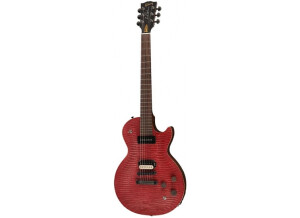
Les Paul BFG
Guitare de forme LP
-

Zakk Wylde Les Paul Bullseye
Guitare de forme LP
-

Les Paul Standard DC
Guitare de forme LP
-
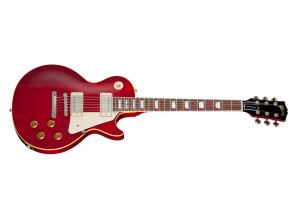
Harrison-Clapton 1957 Les Paul Standard Lucy
Guitare de forme LP
-

Les Paul Goddess
Guitare de forme LP
-

Les Paul Classic (2018)
Guitare de forme LP
-
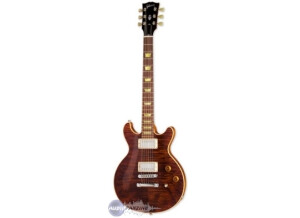
Les Paul DC Pro
Guitare de forme LP
-
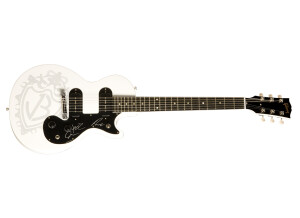
Jonas Brothers Melody Maker
Guitare de forme LP
-
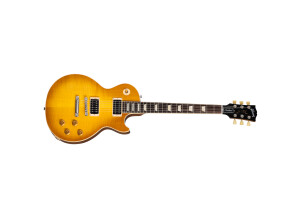
Original Les Paul Standard '50s Faded
Guitare de forme LP
1 929 € neuf (7 offres) -
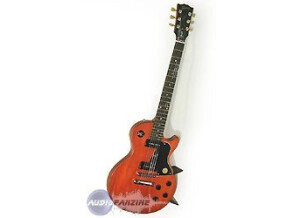
Les Paul Special Faded Reissue (2009)
Guitare de forme LP










